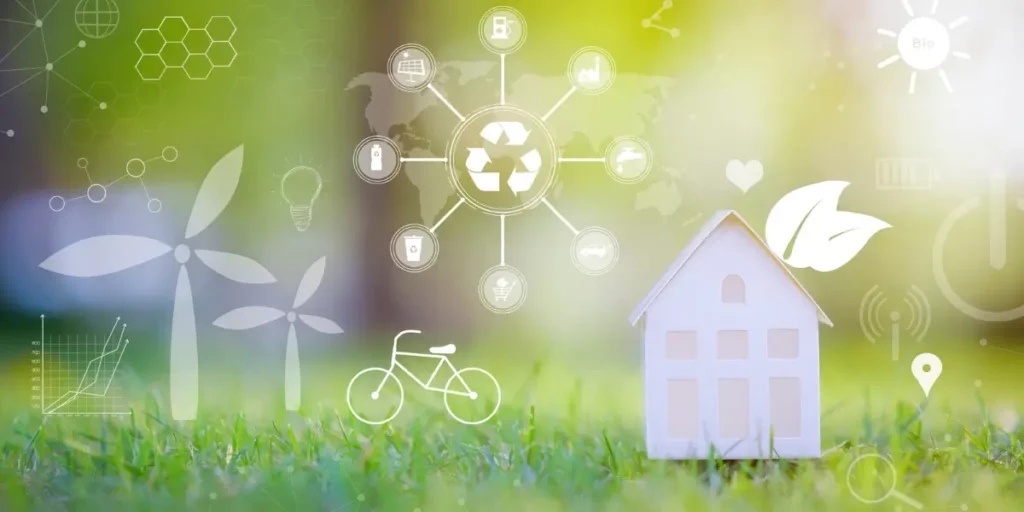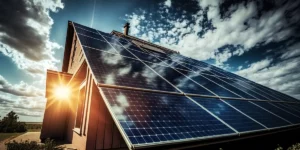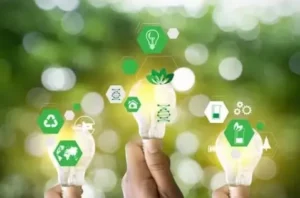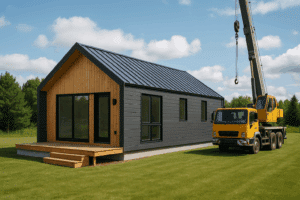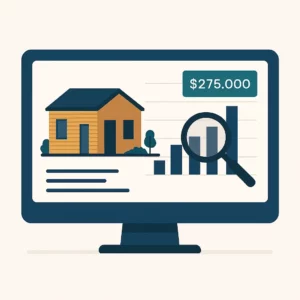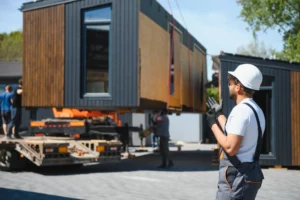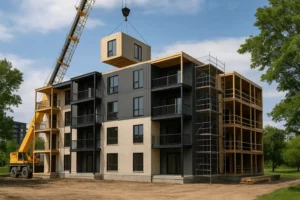The integration of green technologies into prefabricated homes is a growing trend.
Not only do these innovations help reduce the ecological footprint, but they also offer economic and comfort benefits for owners.
This article explores the different green technologies available and their benefits for prefabricated homes.
Are you interested in eco-friendly homes? Discover our platform which centralizes all models and manufacturers of manufactured homes. Compare thousands of models in one place and use our “Eco-Friendly” filter to see the options available in Quebec!
The benefits of green technologies
Reducing carbon footprint
One of the main benefits of green technologies is the significant reduction in the carbon footprint of prefabricated homes. By using sustainable and recycled materials, builders can minimize the CO2 emissions associated with the production and assembly of homes.
Additionally, reducing construction waste through more precise factory planning and manufacturing helps reduce overall environmental impact.
Energy savings
Prefabricated homes incorporating green technologies offer substantial energy savings. Effective thermal insulation, for example, helps maintain a stable indoor temperature throughout the year, reducing the need for heating and cooling.
Additionally, using energy-efficient appliances helps reduce electricity consumption, resulting in savings on energy bills.
Improved comfort
Green technologies not only protect the environment; they also improve occupant comfort.
For example, better indoor air quality can be achieved through the use of non-toxic materials and the implementation of advanced ventilation systems.
In addition, soundproofing solutions help reduce external noise pollution, creating a more peaceful and pleasant indoor environment.
Popular green technologies
Solar panel systems
Solar panel systems are one of the most commonly integrated green technologies in manufactured homes. By capturing the sun's energy, these panels generate renewable electricity for household needs.
This green energy production reduces dependence on fossil fuels and lowers energy costs for homeowners. Solar panels can be installed on the roof or integrated into architectural elements of the home, thus maximizing their efficiency.
Rainwater harvesting systems
Rainwater harvesting systems are another popular green technology. These systems collect and store rainwater for future use, such as irrigating gardens, washing cars, or flushing toilets.
By reducing drinking water consumption, these systems contribute to conserving water resources and lowering water bills. They can be easily integrated into the design of prefabricated homes, with storage tanks and efficient filtration systems.
Solar water heaters
Solar water heaters use the sun's energy to heat domestic water.
This system is particularly effective in sunny regions and can significantly reduce water heating costs, which represent a significant portion of a household's energy expenditure.
Solar water heaters typically consist of solar thermal panels installed on the roof, which heat a heat transfer fluid circulating in a water tank, thus providing hot water in an economical and environmentally friendly manner.
Ecological building materials
Using eco-friendly building materials is essential for the sustainability of prefabricated homes. FSC (Forest Stewardship Council) certified wood is a popular option because it comes from responsibly managed forests.
Additionally, low-carbon concrete, made with industrial by-products such as fly ash, reduces CO2 emissions during its production.
Other materials, such as natural fiber insulation and VOC-free (volatile organic compound) paints, help create a healthy and sustainable indoor environment.
How to Integrate Green Technologies into Your Manufactured Home
Choice of materials
Material selection is crucial for integrating green technologies into your prefabricated home.
- Choose sustainable and eco-friendly materials, such as FSC-certified wood, which guarantees responsible forest management, or low-carbon concrete, which reduces CO2 emissions.
- Also consider natural insulators, such as sheep's wool or cellulose, which offer excellent thermal performance while being environmentally friendly.
- Make sure to choose VOC-free paints and varnishes to maintain good indoor air quality.
Installation of energy systems
Installing green energy systems can transform your manufactured home into a model of sustainability. Start with photovoltaic solar panels to generate renewable electricity.
Combine them with energy storage systems, such as home batteries, to maximize self-consumption and reduce your dependence on the electricity grid.
Solar water heaters are also an excellent option for providing hot water in an environmentally friendly and economical way.
Tips for installing solar panels:
- Position panels on south-facing roofs for maximum sun exposure.
- Make sure the installation is carried out by certified professionals to ensure efficiency and safety.
- Explore financial aid and grants available to reduce installation costs.
Water management systems
Water management systems play a vital role in a green prefabricated home. Install rainwater harvesters to collect and store water, which can be used for garden irrigation or flushing toilets.
Water purification and graywater treatment systems allow for the recycling of water used in the home, thus reducing drinking water consumption and associated costs.
Maintenance and durability
To ensure the longevity of your green technologies, regular maintenance is essential. Clean your solar panels periodically to maintain their efficiency and have them professionally inspected annually.
Maintain rainwater harvesting systems by cleaning filters and checking cisterns to avoid contamination. For building materials, follow manufacturer recommendations to extend their lifespan and ensure performance.
Maximizing the lifespan of technologies:
- Establish a regular maintenance schedule for each green technology installed.
- Use eco-friendly cleaning products to minimize the environmental impact of maintenance.
- Monitor your home's energy and water performance to quickly detect and resolve any problems.
Conclusion
Integrating green technologies into prefabricated homes is more than just a trend; it's a commitment to a sustainable and eco-friendly future.
By choosing eco-friendly materials, installing innovative energy systems, and ensuring regular maintenance, you can transform your home into a model of sustainability. Not only will you reduce your carbon footprint and energy costs, but you'll also enjoy increased comfort and a higher quality of life.
Embrace green technologies today and make your prefabricated home a shining example of what the homes of the future can be.
